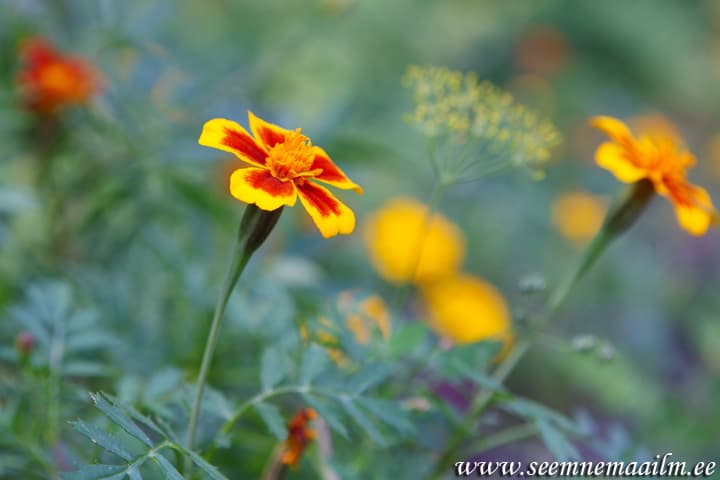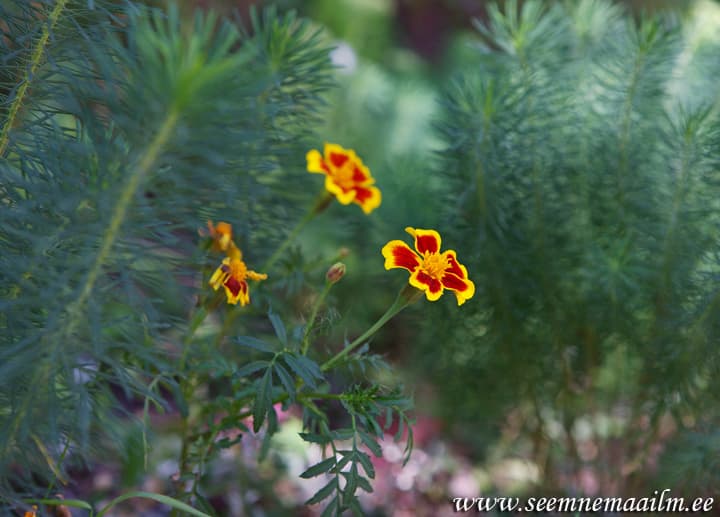Plant height - 20 cm. Flower diameter up to 5 cm.
Even more diverse and generous in flowering, but at the same time, marigolds of the "Pascal" variety are very hardy: starting from June, flowers of an unusual color with an intense aroma bloom, striking with bright radiance and abundance.
The great advantage of the variety: each flower does not lose its decorative effect for about two weeks, thanks to which the bush is a thick yellow ball until October.
Variety "Pascal" deserves a place of honor in flowerpots, containers, balcony boxes, and also successfully fits into any garden ensembles, filling the gaps between neighboring plants, and most advantageously emphasizes their beauty.
Sowing: late May in open ground to a depth of 1.5-2 cm (to accelerate flowering - for seedlings in April). Seedlings are thinned out, maintaining a distance between plants of 15-20 cm. Seedlings are planted in open ground when the threat of frost has passed. The distance between plants is 20-25 cm.
Care: one of the most undemanding crops to care for. They prefer open sunny places, but also grow in partial shade. Undemanding to soil and moisture. For good growth and flowering, young plants need to be watered and fed (two or three top dressings with an interval of 7-10 days). To prolong flowering, faded flowers must be removed.
Flowering: June to frost.

Marigolds, strewn with single flowers, 20-30 cm high are unpretentious, fast-growing, light- and heat-loving, drought-resistant plants.
The optimum temperature for the growth of young plants is + 18 + 20 ° C.
At temperatures below + 10 ° C, the leaves acquire an anthocyanin bloom and growth stops. Plants die at -1 ..- 2 ° C.

French marigold single. Bot.: Tagetes patula nana.
Location: do not need intense sunlight, although maximum decorative effect is achieved in sunny places. This is especially true for thin-leaved marigolds. Poorly tolerate spring and autumn frosts.
Soil: require nutritious, well-moistened soils in the first half of summer.
Care: considered drought-resistant, but at the beginning of growth they need watering, otherwise the plants will be puny and the inflorescences small. Marigolds, especially erect marigolds, are negatively related to excess moisture in the soil. In rainy weather, their large inflorescences begin to rot. And if the soil is oversaturated with water, the plants begin to die from fungal root diseases. Fertilizing in the spring will result in strong growth and delayed flowering.
Diseases and pests: inflorescences often rot during prolonged rains. In dry, hot conditions, marigolds are affected by spider mites. To rid plants of it, you must first of all increase the humidity of the air by spraying the seedlings several times a day with water. For complete destruction, 2-3 times spraying with infusions of onions, hot red pepper, yarrow is used.
Reproduction: seeds. Marigolds can be sown in open ground in late May - early June. Seedlings appear 5-10 days after sowing. It is desirable to cover the soil with non-woven material (acrylic, lutrasil). In this case, you can sow a week and a half earlier than usual and thereby accelerate flowering. When growing seedlings earlier than others, in mid-March, upright marigolds are sown.
Marigolds rejected and thin-leaved are sown in early April. Subject to these terms, flowering of all three species will begin in June.
Marigold seedlings are easy to grow at room conditions on a bright window, and even better in film greenhouses, where the plants will be the strongest. To make the seedlings healthy, you need loose, nutritious soil (1 part of humus + 1 part of peat + 1 part of sod land + 0.5 parts of sand), an even temperature of + 18 + 22 ° C and moderate watering. Marigolds are less demanding on soil and temperature.
Although marigold seedlings are considered unpretentious, it is better to take fresh soil for sowing, especially for narrow-leaved marigolds, which are more affected by the "black leg" than other species.
Seedlings can be grown in a box, bowl or pot. At the bottom it is necessary to pour drainage (crushed stone, expanded clay, coarse sand) with a layer of 3 cm or make holes. Otherwise, plants may die from fungal diseases. First, 2/3 of the soil is poured onto the drainage, and this layer is compacted by hand or with a rammer. The next layer should be loose so that the germinating roots have enough air. The soil should not reach the edge of the container by 1-2 cm. The prepared soil is well shed and left for one or two days in a warm place so that it "breathes".
Marigold seeds are large, therefore they can be carefully spread out in the grooves at a distance of 1-1.5 cm. The distance between the grooves themselves is 1.5-2 cm. Thickened seedlings suffer more from a lack of light and stretch. They may even develop blackleg.
The easiest way to get optimal density is by sowing germinated seeds. For germination, they need to be spread out on a damp cloth on a saucer and put in a plastic bag, put in a warm place. After 2-3 days, the seeds will hatch. The decomposed seeds are covered with a layer of earth of 0.5-1 cm (weakly covered seeds may die from drying out). If the seeds are planted too deep into the soil, they may not sprout at all, especially in narrow-leaved marigolds.
After sowing, the top layer of the earth is carefully watered, then covered with paper. The containers are placed in a warm place (+ 22 + 25 ° С) and the soil moisture is carefully monitored. After 3-7 days, seedlings will appear and the containers should be transferred to a bright place at a lower temperature (+18+20°C).
If the seedlings are still thickened, then it must be dived: for this, the seedlings are carefully removed from well-moistened soil, transplanted into a hole, deepened to the cotyledons, which will contribute to the effective formation of new roots.
Good seedlings by the time of planting have 2-3 pairs of leaves and a powerful root system. Seedlings are planted in the ground in late May-early June. Plants are planted in the soil deeper by 1-2 cm than they grew before. The distance between plants depends on the species and variety. High hybrids and varieties of upright marigolds are planted according to the scheme 40x40 cm, medium varieties and hybrids F1 30x30 cm and low varieties and hybrids of all types 20x20 cm.
The transplant is easily tolerated at any age, even in a flowering state.
Use: secretions from the roots of marigolds reduce the damage of other plants by fungal diseases and especially Fusarium, protect against certain types of nematodes.
Marigolds erect can be grown for cutting. They stay in water for about three weeks.
Marigolds are used in all types of flower beds. They are not suitable only for a pond and a shady garden. They tolerate marigolds and harsh conditions of a small amount of soil. Therefore, they grow well in pots on the windows, they decorate the premises, as well as primroses or cineraria. Marigolds can be planted in a pot or box in the fall before frost. There are cases that they survive in the winter, and in the spring they form a large flowering bush (this only applies to rejected marigolds).












